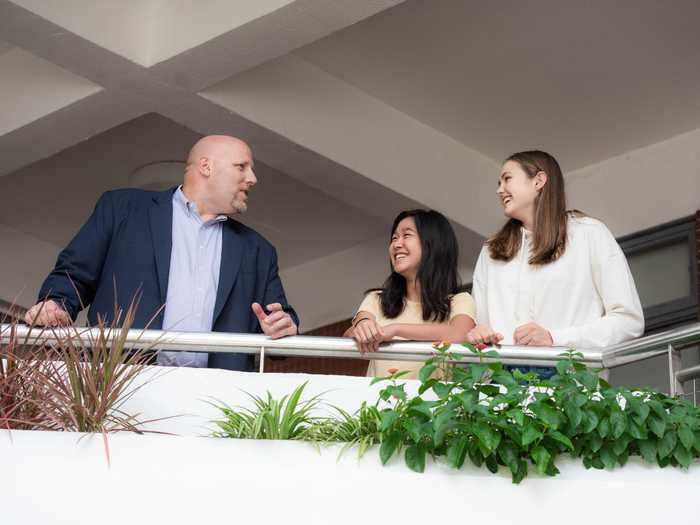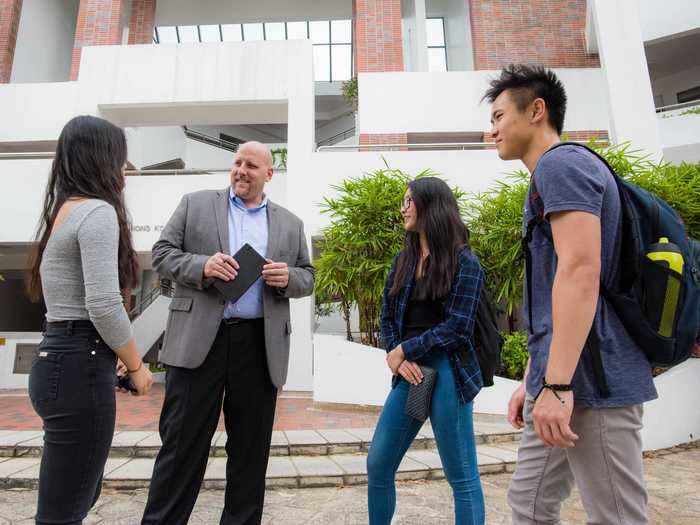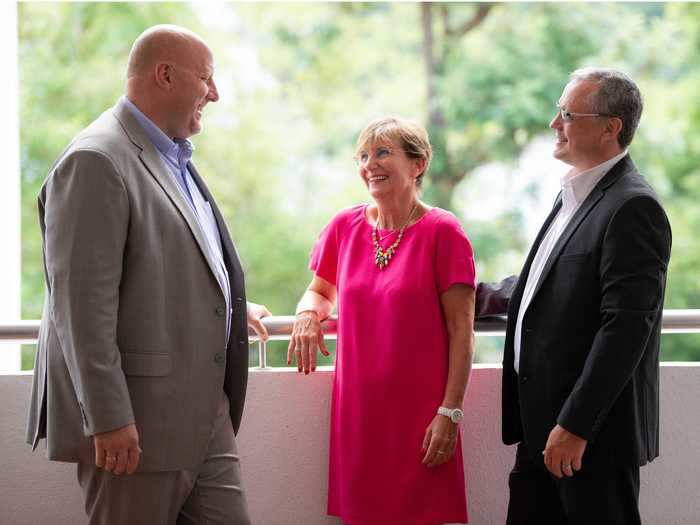David Lovelin welcoming students to campus.Courtesy photo
- Dr. David Lovelin is the high school principal of Hong Kong International School. He's been a school administrator for 15 years throughout South Korea and the US.
- After their school was forced to close in early January due to COVID-19, Lovelin and his faculty were faced with creating a remote learning plan for their 2,800 students of 40 different nationalities.
- What he and his team are seeing from students and educators today is likely what US schools can expect as their closures continue.
- It's important to have centralized communication, develop a daily routine, and meet weekly expectations, Lovelin says, to keep students on track and make them feel supported.
- Visit Business Insider's homepage for more stories.
As the COVID-19 virus hit our city, the leadership here at Hong Kong International began creating a blueprint for distance learning that K-12 schools around the world can hopefully learn from.
The government in Hong Kong closed schools in early January, meaning we're a solid couple of months further along in this journey than most American schools.
Over this time our school, an American-style preparatory school serving 2,800 students of 40 nationalities, has enacted the distance learning experiences from previous school closures to enable students to thrive, even if they could not be inside our buildings.
For Hong Kong International, distance learning is not entirely unprecedented. We had an initial period of distance learning days in the fall of 2019 due to protests in Hong Kong. Once we returned, we started planning what we needed for future remote-learning situations, much as many schools in the US are now doing.
What we're seeing from our students and educators today is likely what US schools can expect as their closures continue.
Read the original article on
Business Insider
Create new opportunities
Lovelin and students on campus.
Courtesy photo
While the reach of this tragedy is tremendous, we see glimmers of innovation and creativity driven by the tremendous and sudden changes facing society. Our school uses both formative and summative assessments. For those not in education, this means that summative grades — assessments that tell students how they did at the end of a grading period — are complemented by ongoing feedback that helps them grow throughout the period. The latter is what we call formative assessments. As a growing number of schools leverage emerging technologies out of necessity, we can use analytics and data to benefit our students' learning.
We have been able to maintain our commitment to ongoing assessments, enabling us to provide our students with end of year grades and credits. One important aspect of maintaining our standards is the availability of our faculty through structured office hours each day through Schoology.
This is a difficult time for educators across the globe. It's our hope that educators and administrators learn from our experiences.
Dr. David Lovelin has been an administrator for the past 15 years in several different roles and is currently the high school principal for Hong Kong International School. Previously, Dr. Lovelin worked at Korea International School and in the US in varied leadership roles and with a continued commitment for developing innovative education programs, promoting a positive culture, building relationships, and grounded in supporting all learners.
Students crave routine
Lovelin with students on campus.
Courtesy photo
I began my career in education in the US and have heard from my friends, family, and former colleagues that many parents and educators are giving kids extra flexibility and downtime in hopes of providing a silver lining during this stressful, disruptive time. I can understand the logic — extra video games might cheer up a kid who is missing their schoolmates.
When we moved to temporary distance learning in the fall, some of our students left Hong Kong temporarily. With the many time zones in mind, we thought it best to let kids learn on their own schedules. In short, it could've been smoother.
When the COVID-19 crisis began, we followed the bell schedule from day one. We've moved toward consistency in all online structures, resources, and schedules. Everything is contained in the Schoology Learning Management System, the hub for all our online learning.
Educators, parents, and students know where to find things, when instruction will begin, and what expectations are. With a centralized digital hub in place, communications became easier and we learned quickly that overcommunicating expectations while soliciting ongoing feedback from students, parents, and faculty was key to ensure members of our learning community feel heard.
Today, attendance hovers around 90%, close to our typical numbers. We've made it possible for students to access information and lessons even if they can't tune in with the live class. Parents and teachers can be accommodating in these difficult times, while also emphasizing structure to give students a sense of personal responsibility and routine.
Question what you think you know
David Lovelin with fellow faculty members Lauren Fine and Brent Brayko.
Courtesy photo
Like many principals, I generally can intuit how students and faculty are doing within my school. And it tends to follow patterns I've seen over my career. Periods of heightened dedication coupled with anxiety as we head into semester finals, followed by distraction as students near vacation, for example. Those norms are no longer the case.
While I still am in close contact with my colleagues and have virtual touchpoints with students, I can't make assumptions about the "typical" way students react and feel throughout the school year. Ongoing parent and student surveys have been hugely valuable in understanding our students' needs.
Over time, as our community has gotten used to remote learning, responses have focused more on the social and emotional well-being of our kids. Schools provide more than an education, they're the number one community for kids. My kids felt sad, as I'm sure many American kids are starting to feel. They are actually grieving for what they've lost.
We introduced daily interactive challenges to help foster the sense of community that kids miss. This is something that administrators and teachers in the midst of doing distance learning could bake in now.
We also turned to the students to help solve this problem. The Student Senate has been developing daily and weekly challenges for our students and faculty, which has made a positive impact on our community. Even our PE program has made a large shift to create daily workout plans that can be used both individually and with our families. We are focused on trying to create a positive experience for our students, even in a very challenging environment, and continue working through multiple plans for our seniors.



